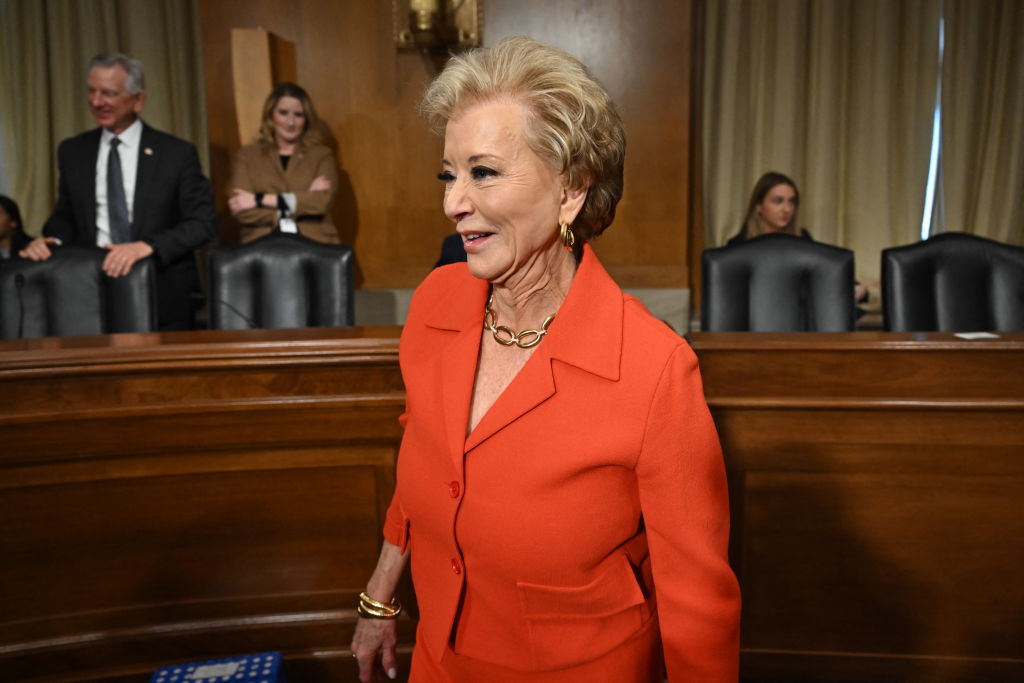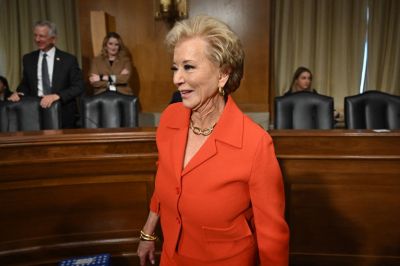Judging from the rhetoric emanating from Washington, D.C., the U.S. Department of Education appears to be living on borrowed time. President Donald Trump has said that he wants to scale it down, then work with Congress to abolish it. His nominee for education secretary, Linda McMahon, echoed that intention in her confirmation hearing.
In the Trump administration’s push to reduce the size of the federal government, the Education Department looks like an easy target. The smallest Cabinet agency, with around 4,000 employees, it is sometimes controversial but rarely a centerpiece in D.C. politics and policy, partly because education funding and policy are overwhelmingly state and local issues. In recent years, however, the department’s total dollar impact has grown because of its student debt portfolio, now totaling around $1.6 trillion.
Democrats view the possibility of eliminating the Education Department as though a wrecking ball is headed straight for American classrooms, while Republicans react as though Trump’s Department of Government Efficiency is targeting an abandoned office building in Washington, D.C. Neither perspective is quite right, but questions abound as to how far the administration can diminish the department’s responsibilities without congressional approval.
The department’s expanding role.
Congress created the first U.S. Department of Education in 1867, and its only role was to collect and report certain data. Controversial from the start, it was downgraded to an office and later recast as a bureau, then in 1953 became part of the new Department of Health, Education and Welfare. This was the era of Brown vs. Board of Education, and the Office of Education had a growing role in civil rights enforcement.
Relatively limited federal involvement in education continued until 1965, when LBJ’s Great Society brought the Higher Education Act and the Elementary and Secondary Education Act, each of which is still in the Education Department’s portfolio. The department also enforces civil rights laws relating to race (1964), sex (1972), disability (1973), and age (1975). Before the modern Department of Education came into being in 1980, its duties were largely handled by the Office of Education within HEW.
By the 1970s, the National Education Association wanted a Cabinet-level Department of Education, and in his 1976 presidential campaign Jimmy Carter promised to create one. The idea encountered stiff resistance in Congress, though, as the American Federation of Teachers, another teachers union, opposed the idea on the grounds that the issue of education could not be separated from issues of health and welfare. In the end, Congress created the U.S. Department of Education in 1979. On the campaign trail in 1980, Ronald Reagan promised to abolish it, and told his first education secretary to put himself out of a job. Instead, the agency commissioned A Nation at Risk, a critique of the state of American learning that cemented the department’s role. Since then, GOP platforms have called for reducing the federal role in education, and sometimes abolishing the department.
A portfolio that doesn’t include education.
So what exactly does the Department of Education do? One of the things it doesn’t do is education. A statutory “prohibition against Federal control of education” makes it illegal for any part of the federal government to direct the “curriculum, program of instruction, administration, or personnel” of any school or university. This kind of restriction is common, appearing in other statutes that define the permissible activities of the department.
What the department does do is (a) spend money, and (b) make and enforce rules.
Let’s start with money. At the K-12 level, federal money forms about 10 percent of the roughly $950 billion the United States spends on public schooling. The biggest chunks of the federal share support special education students under the Individuals with Disabilities Education Act and students from lower-income families under Title I of the Elementary and Secondary Education Act. Smaller expenditures go to a long list of more targeted programs like English language learning, teacher training, education for children of migrant workers, school safety, and so on; this is done largely through grants to school districts, charter schools, and the like.
The money flowing to colleges and universities is mainly federal student aid—around $110 billion a year in grants, loans, and work-study funds. The $45 billion in grant revenue research universities receive from the National Institutes of Health and the National Science Foundation does not come from the Education Department.
What rules does the Education Department enforce? The Office for Civil Rights (OCR) enforces race, sex, disability, and age discrimination laws. We naturally associate civil rights with race, and that has gained a renewed significance in education after the Supreme Court’s 2023 decision in Students for Fair Admissions v. Harvard. Last Friday, the Office for Civil Rights issued a “Dear Colleague” letter making it clear that racial discrimination in any form may draw an investigation. Such missives do not change the law at all, but they are a pretty good indication of where enforcement will be focused.
Another hotly contested arena is Title IX, which bars discrimination on the basis of sex. And a perennial enforcement focus for OCR is disability. These laws also are enforced by the U.S. Department of Justice’s Educational Opportunities Section as well as agencies in each state.
Beyond civil rights, other rules made and enforced by the Education Department govern eligibility for student aid, recognition of education accreditors, conditions on federal grant money, and so on.
The department’s enforcement tools are generally limited. OCR, for example, primarily investigates complaints and tries to resolve them through voluntary compliance. If enforcement through the courts is required, the Department of Justice litigates on behalf of the Department of Education.
Abolishing the department.
Could President Trump try to abolish the department by executive order? When asked this question earlier this month, he said, “Well, there are some people that say I could. I think I’d work with Congress.” McMahon made similar comments in her confirmation hearing. Congress created the department, so Congress would need to disband it.
Might Congress do this? Republicans have the narrowest House majority in the modern era, and in 2023 60 House Republicans voted against abolishing it. If the House did manage to pass a bill abolishing the department, Senate Republicans would have to be joined by seven Democrats to clear the filibuster hurdle.
The Trump administration is already seeking to curb the department’s activities, though, so the question is how far it can go without the involvement of Congress. This depends on whether the president eliminates any of the department’s offices, and if he can decline to spend money appropriated to the department by Congress.
As far as eliminating offices within Education, each one appears to have been created by statute, meaning Congress would have to pass a law to eliminate it. The executive branch can’t act alone.
For example, the Institute of Education Sciences (IES), an office within the Education Department that handles statistics and other data gathering and reporting, has reportedly had at least 89 of its contracts canceled—a reduction said to be worth $900 million. IES was created by the Education Sciences Reform Act, so Congress would need to pass a law to get rid of it. But can the executive branch cut its spending without the consent of Congress? IES was funded in 2024 by a specific appropriation of $793,106,000 (see page 232 here), and that funding was extended by a continuing resolution. It’s unknown whether the administration intends to spend less than this amount in 2025.
This gets to the question of impoundment—i.e., the practice of not spending all congressionally appropriated monies. In the early legal skirmishes over this issue, courts have held that the president must spend the money, citing precedents authored by a young Brett Kavanaugh and an even younger William Rehnquist. But it is likely a case-by-case question. The appropriation for IES, for example, says, “[f]or necessary expenses of [IES] … $793,106,000, which shall remain available through September 30, 2025.” The appropriation for OCR is even simpler: “[f]or expenses necessary for the Office for Civil Rights, $39,798,000.” Neither passage appears to constitute a command to spend all of the money, but other legal factors will come into play as the courts assess the extent to which the Trump administration can spend less than what Congress has appropriated.
These fine distinctions may not matter to the administration, however. Mark Paoletta, general counsel of the Office of Management and Budget, has laid out in detail his argument that impoundment is long-standing practice, the Impoundment Control Act of 1974 is inconsistent with the constitutional structure, and therefore it is an unconstitutional encroachment on executive branch discretion. This suggests that we will see plenty of spending cuts, not just at Education but across all agencies, and the issue will presumably be resolved by the Supreme Court.






Please note that we at The Dispatch hold ourselves, our work, and our commenters to a higher standard than other places on the internet. We welcome comments that foster genuine debate or discussion—including comments critical of us or our work—but responses that include ad hominem attacks on fellow Dispatch members or are intended to stoke fear and anger may be moderated.
With your membership, you only have the ability to comment on The Morning Dispatch articles. Consider upgrading to join the conversation everywhere.